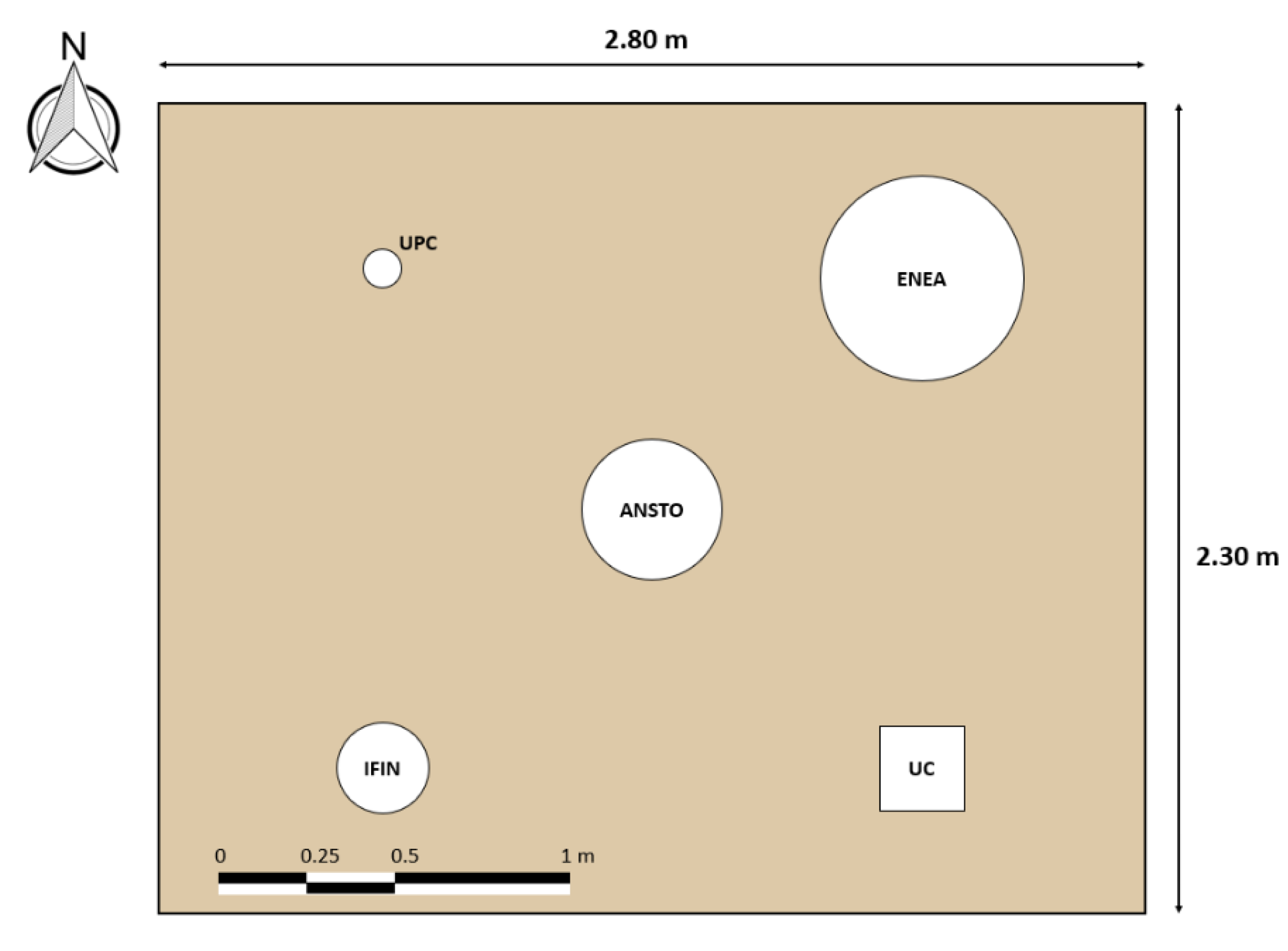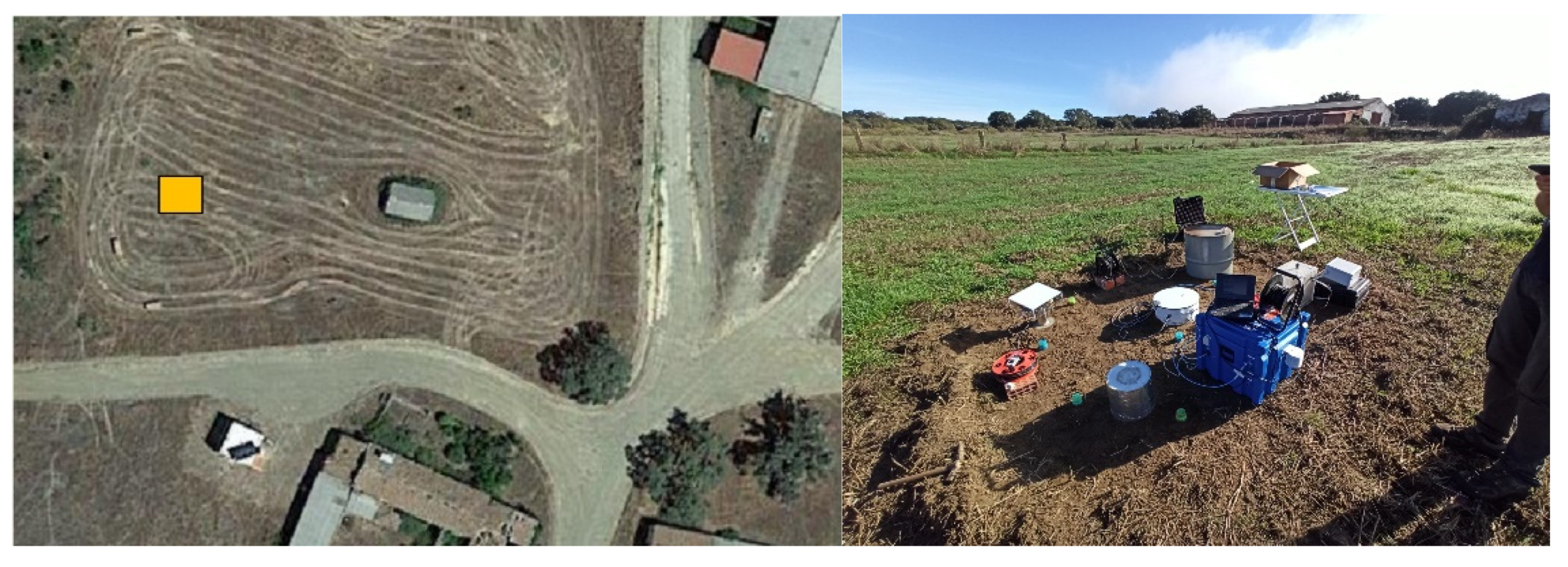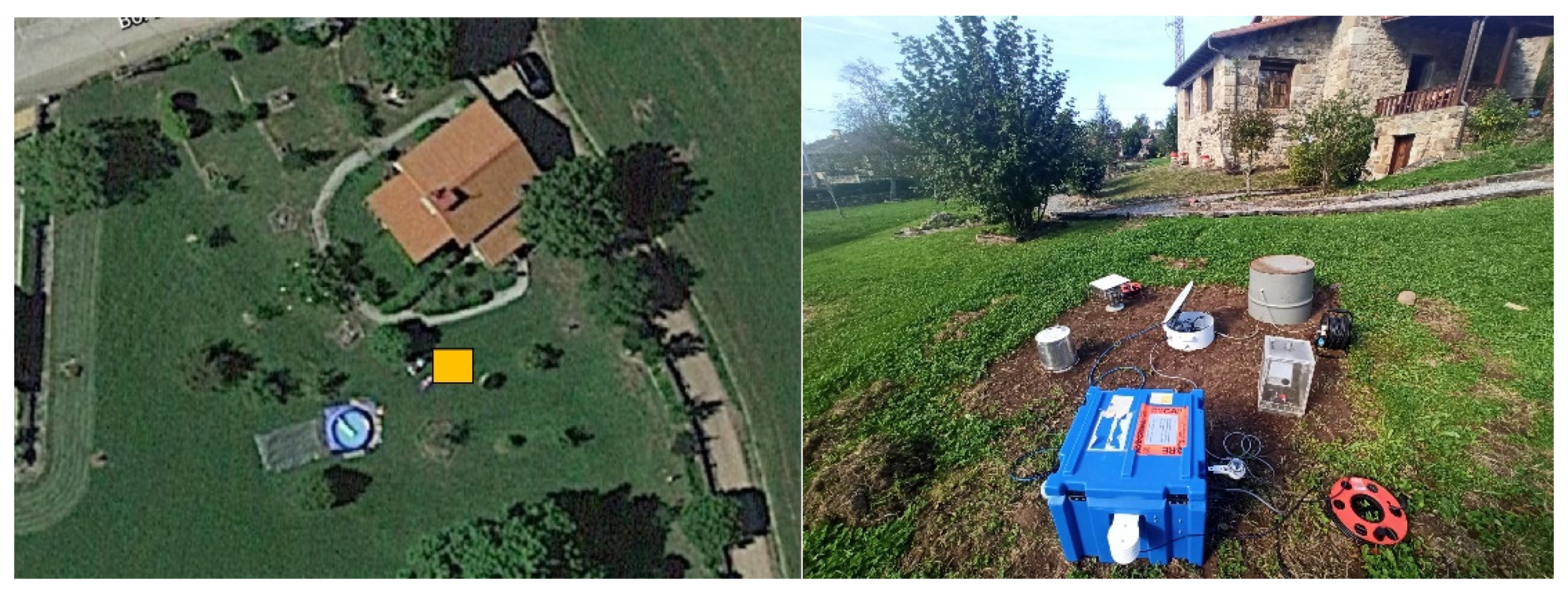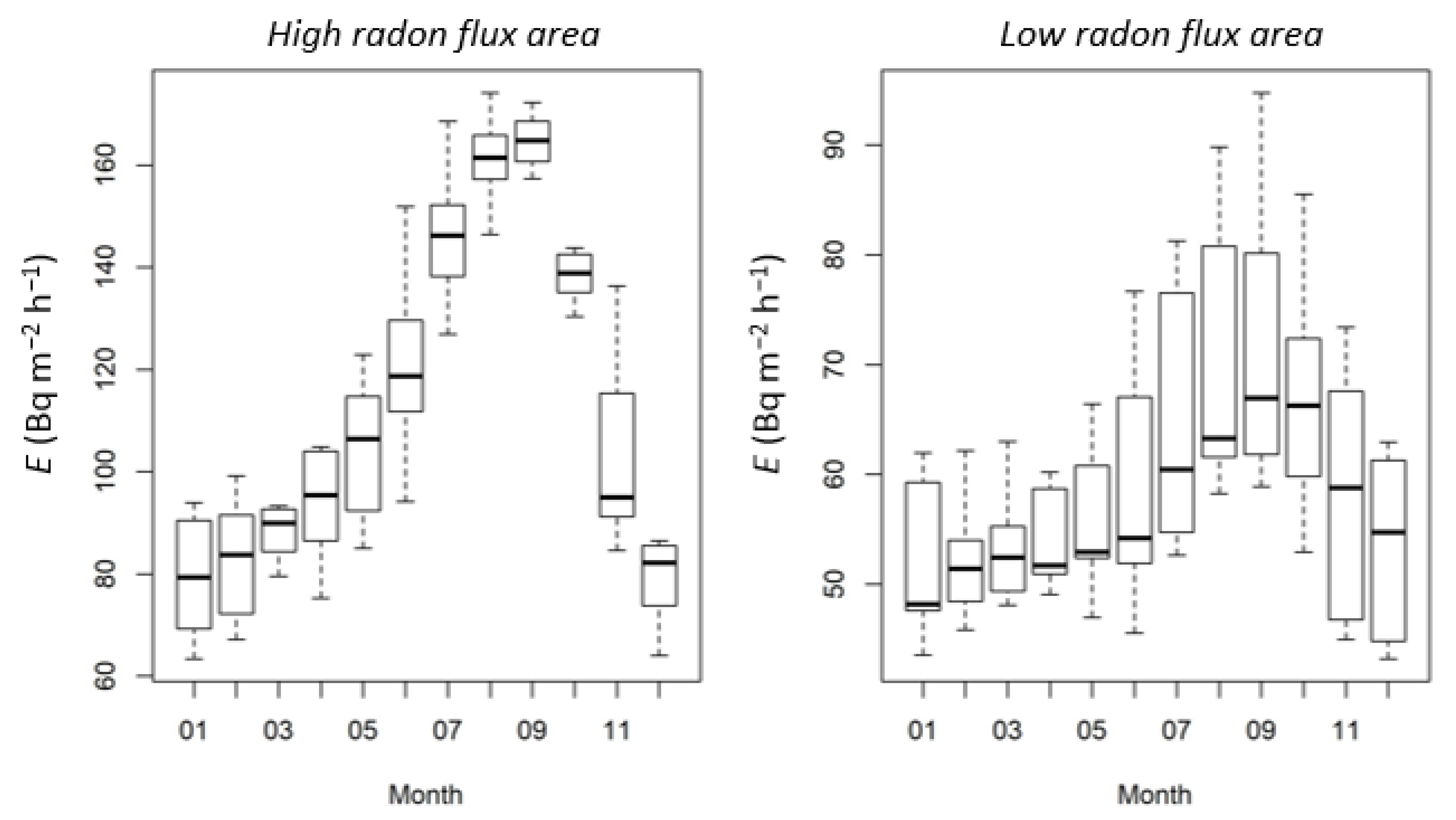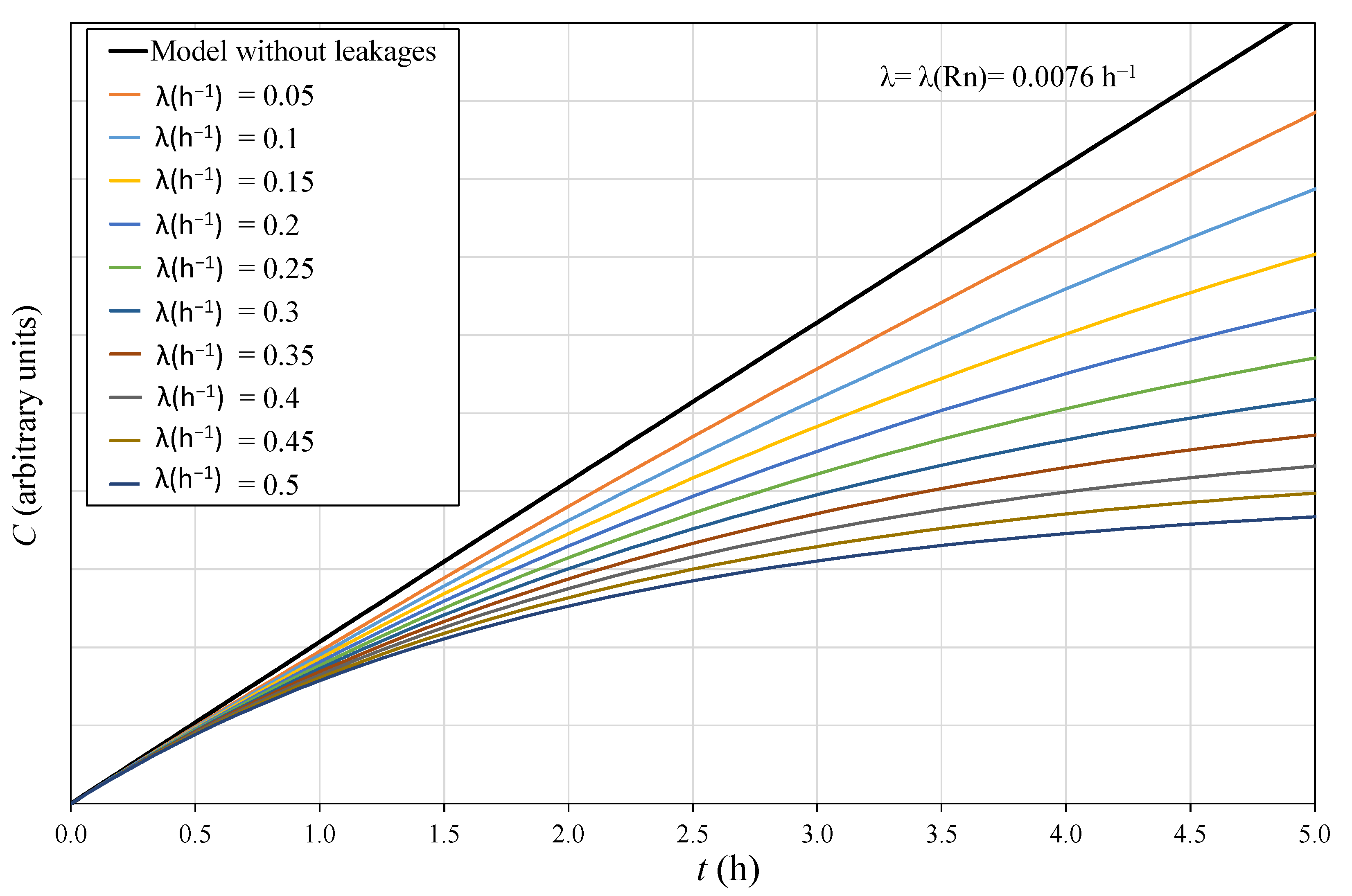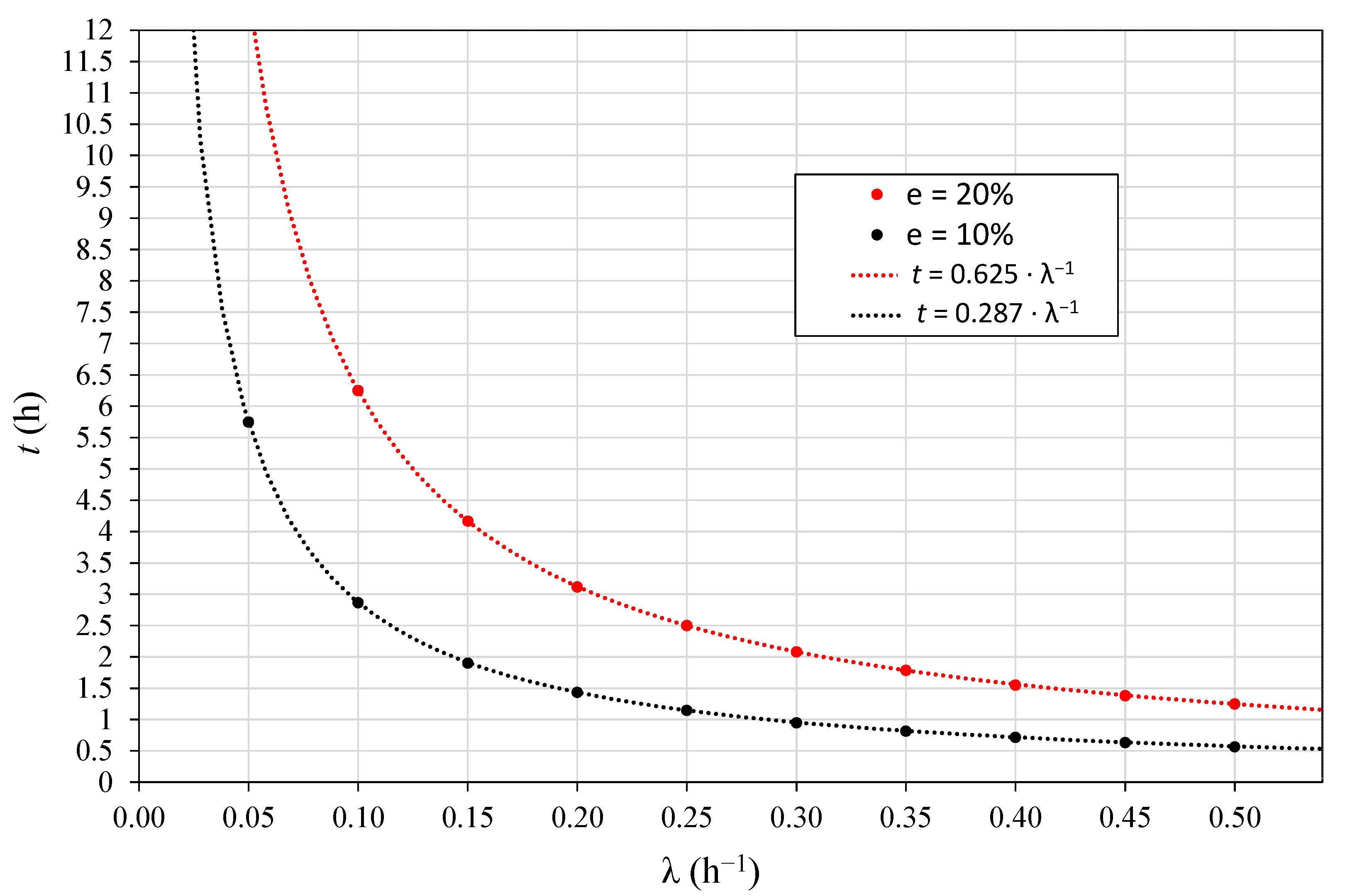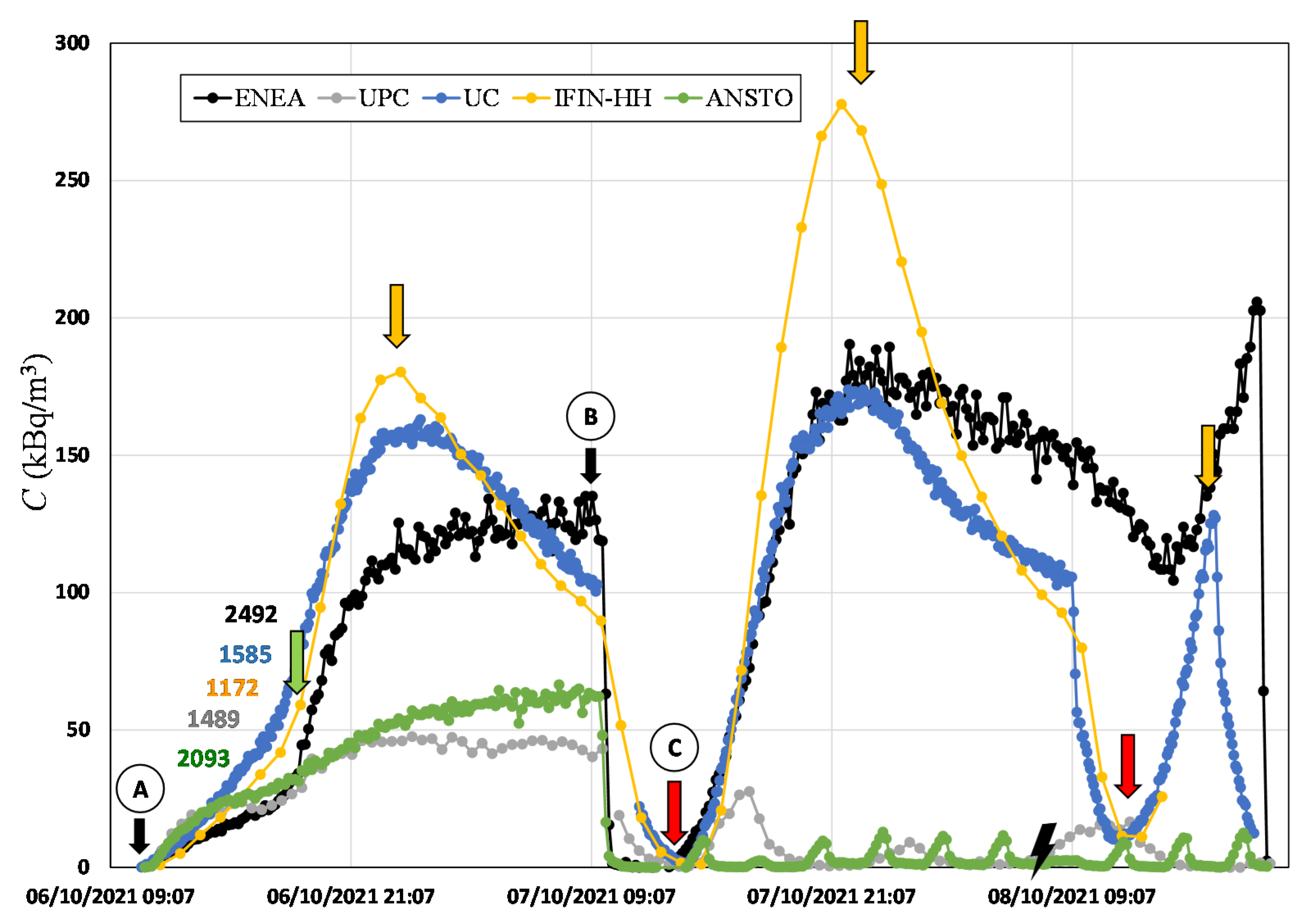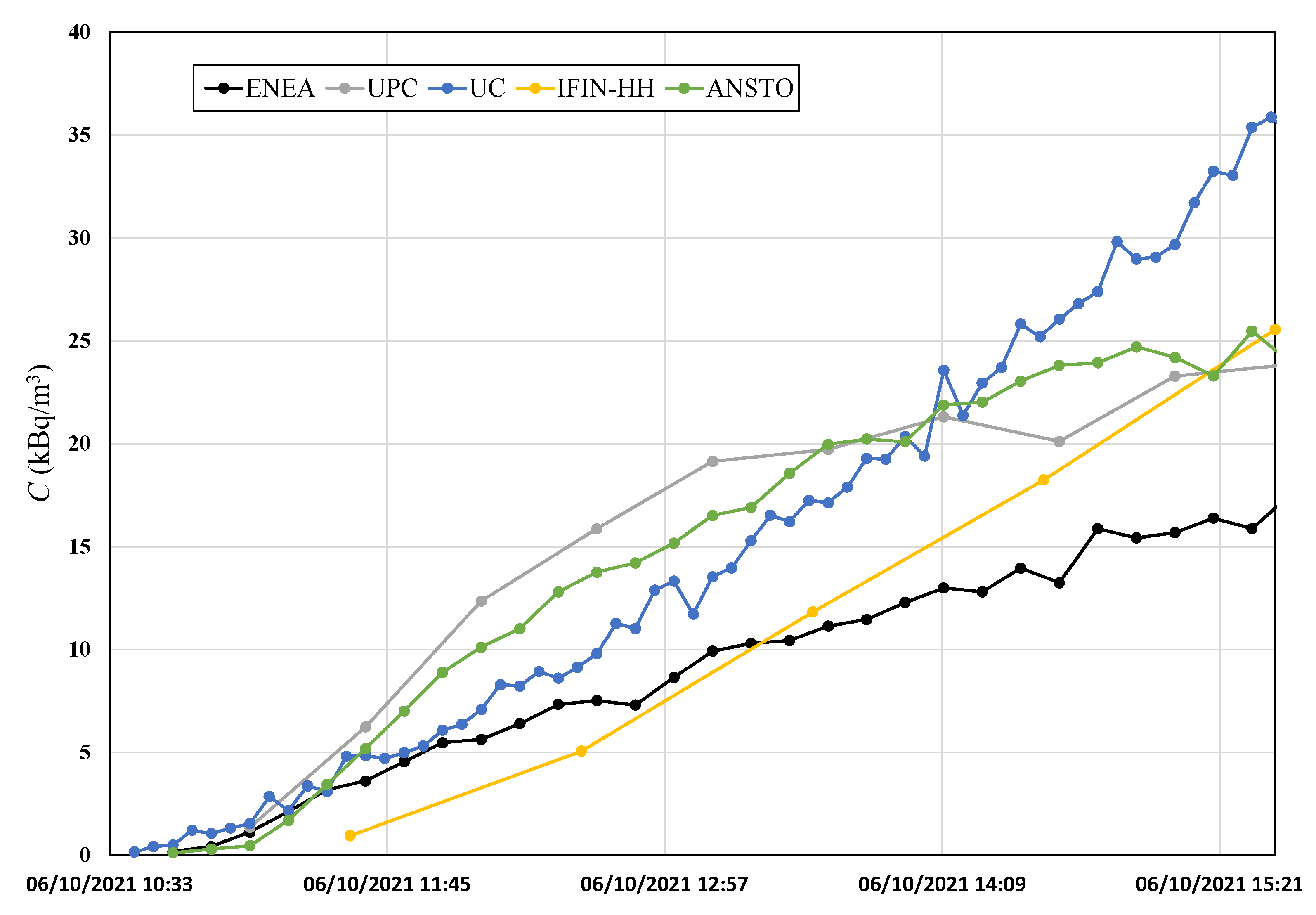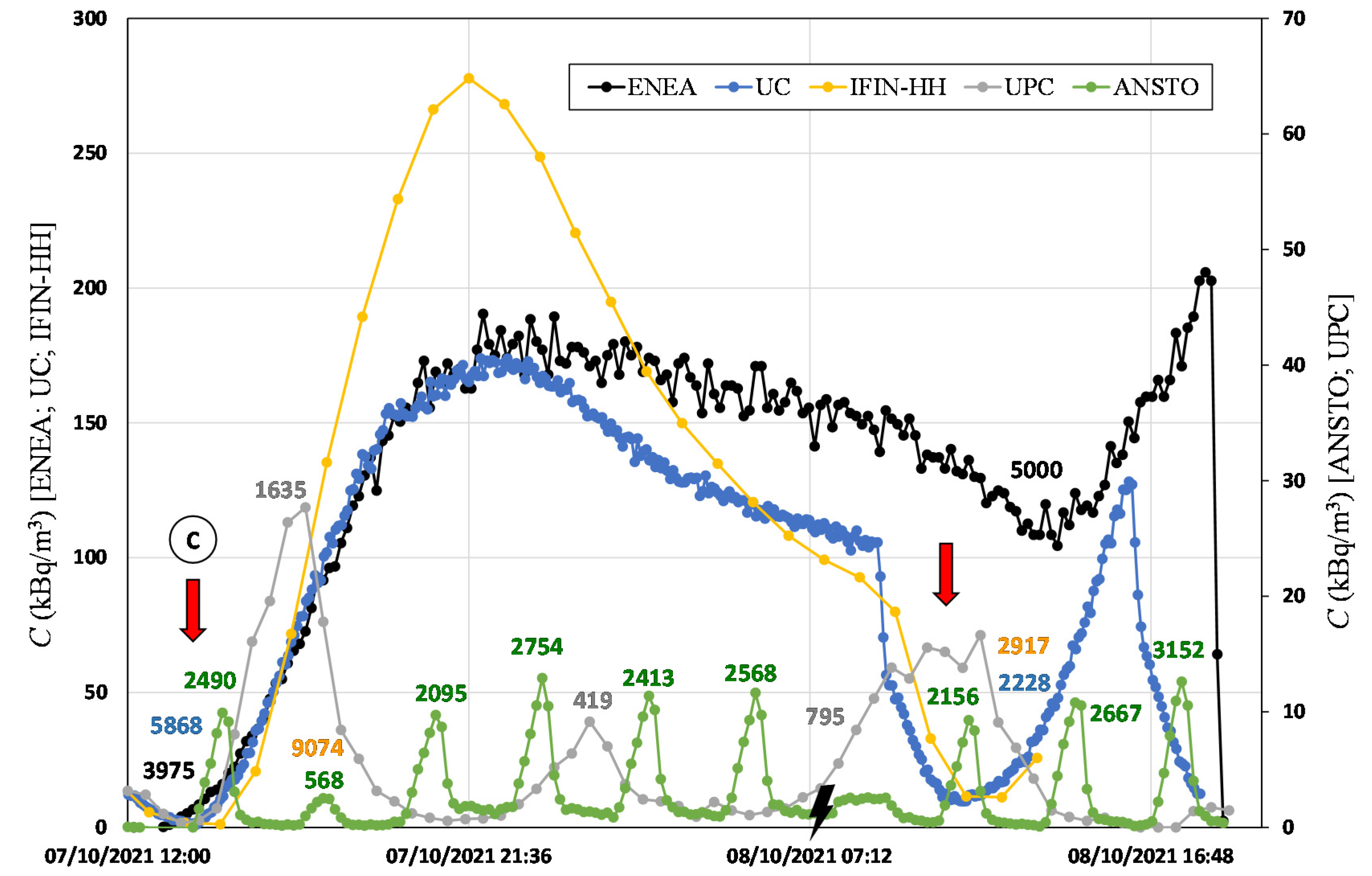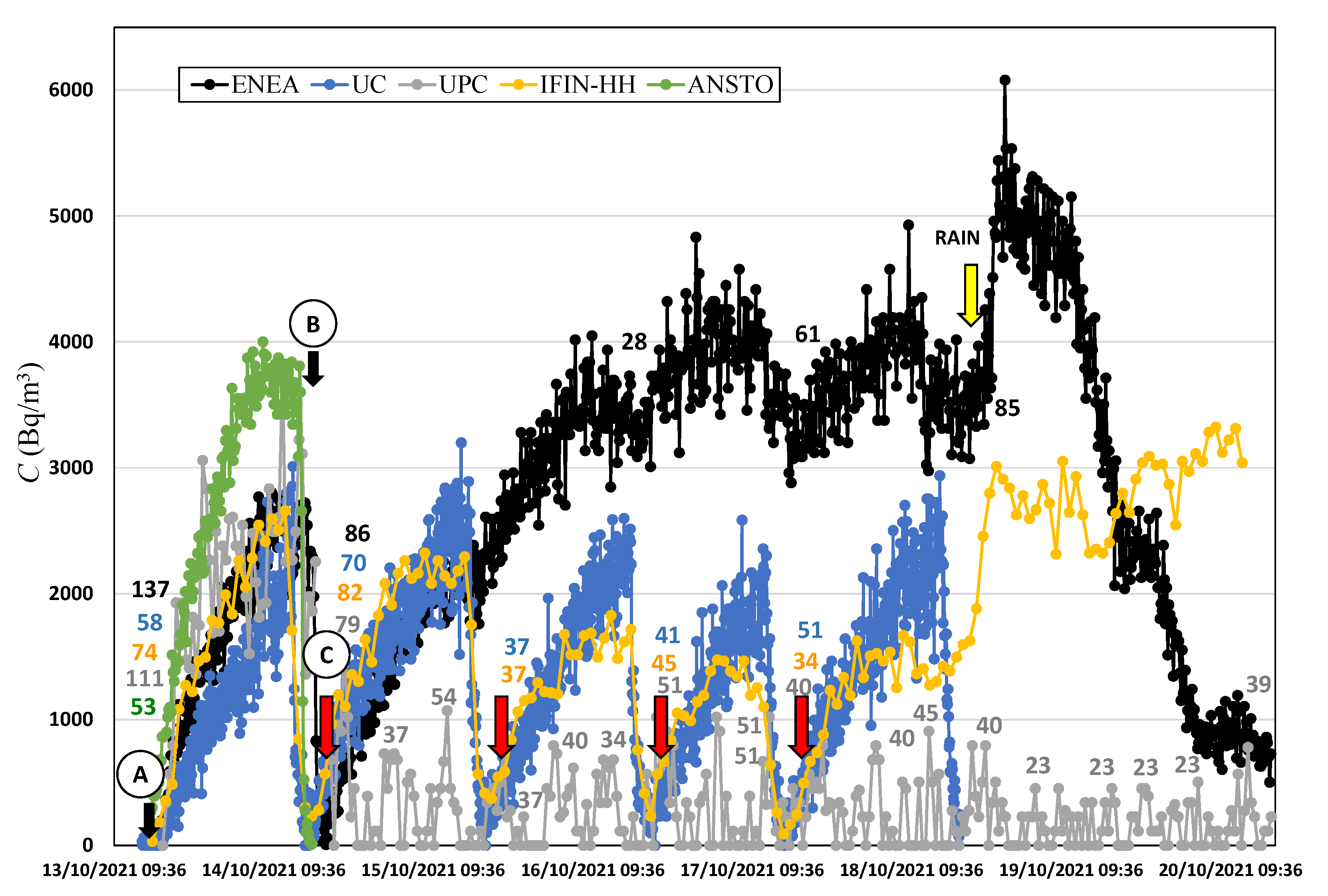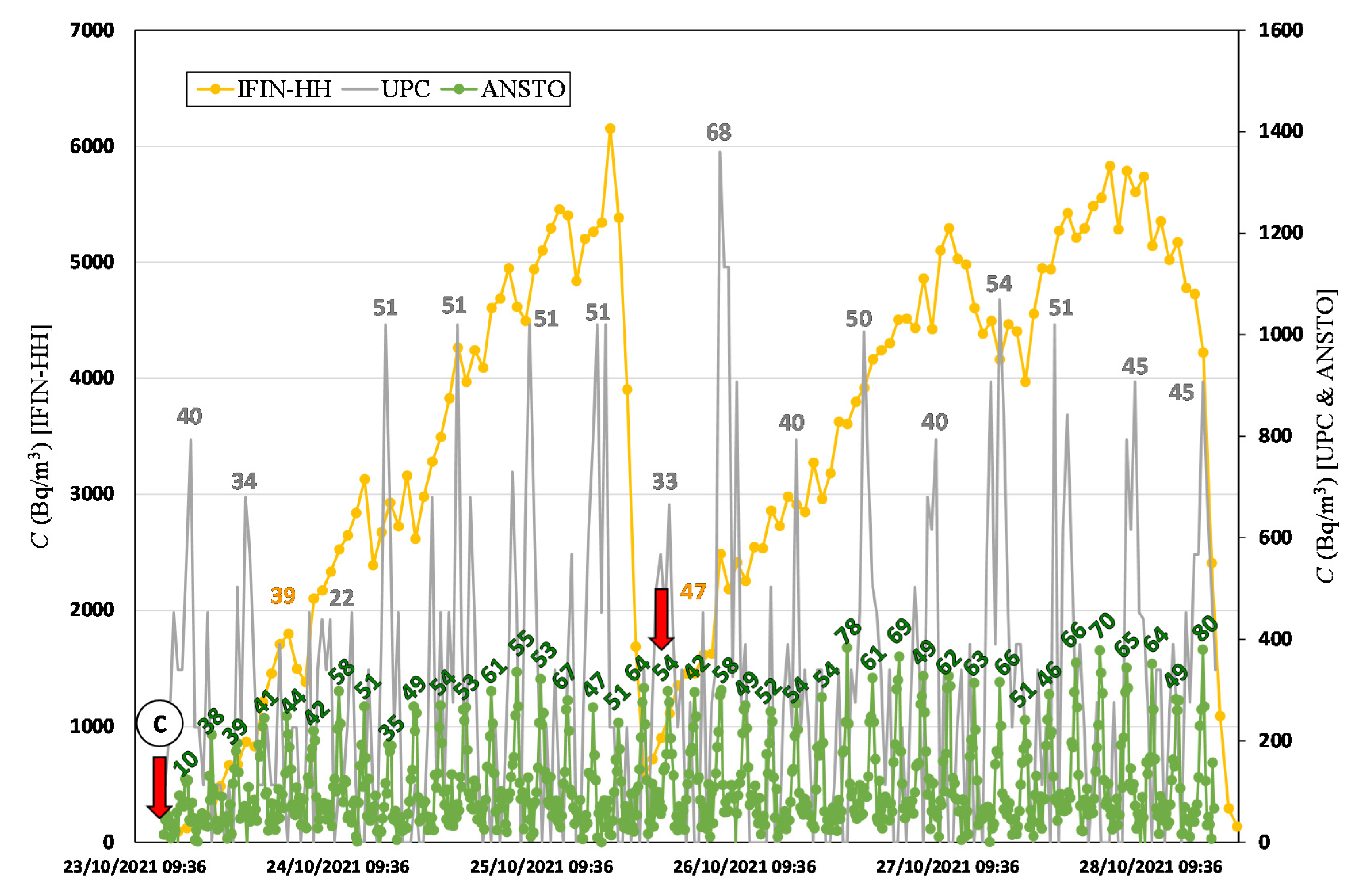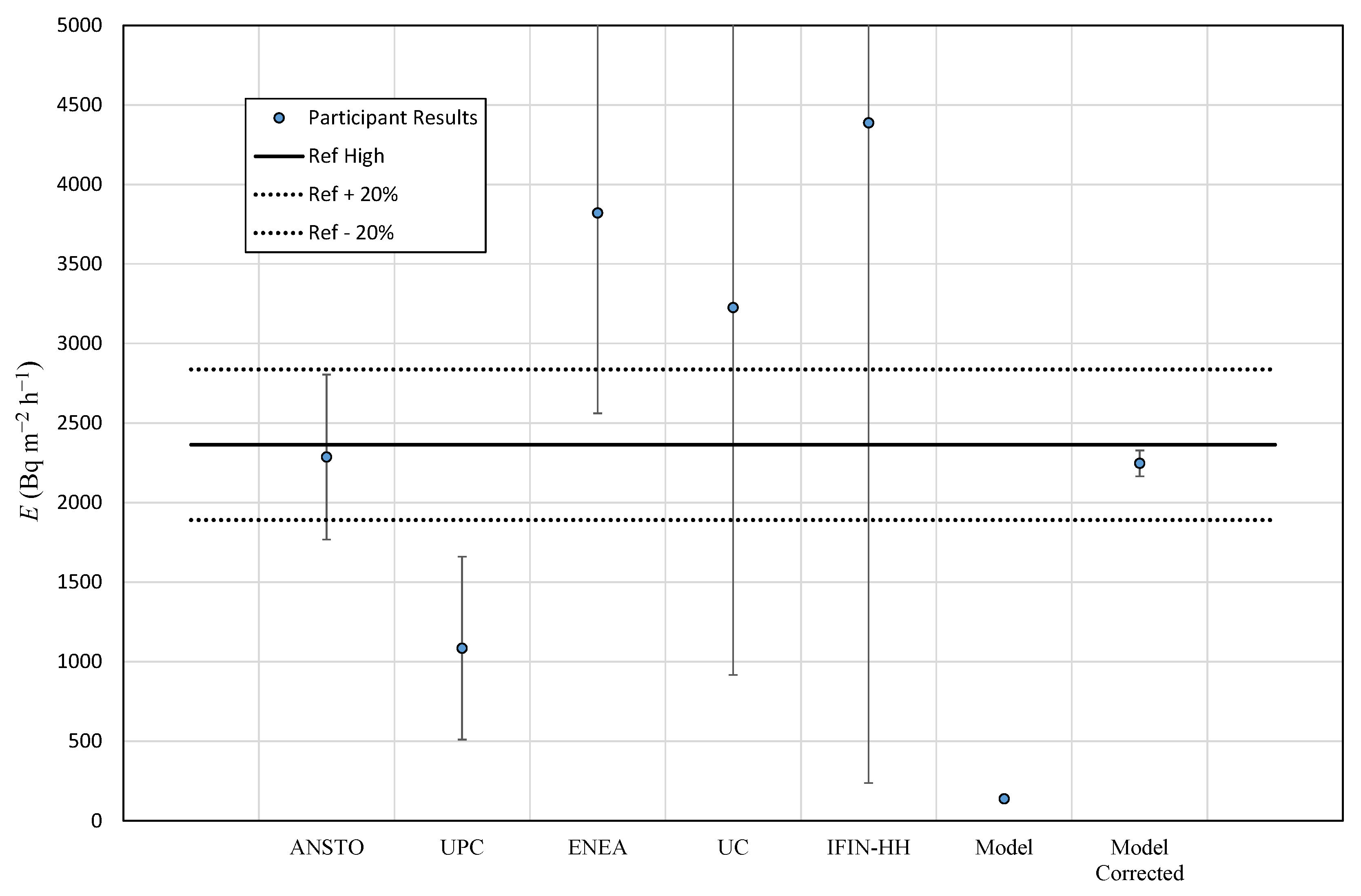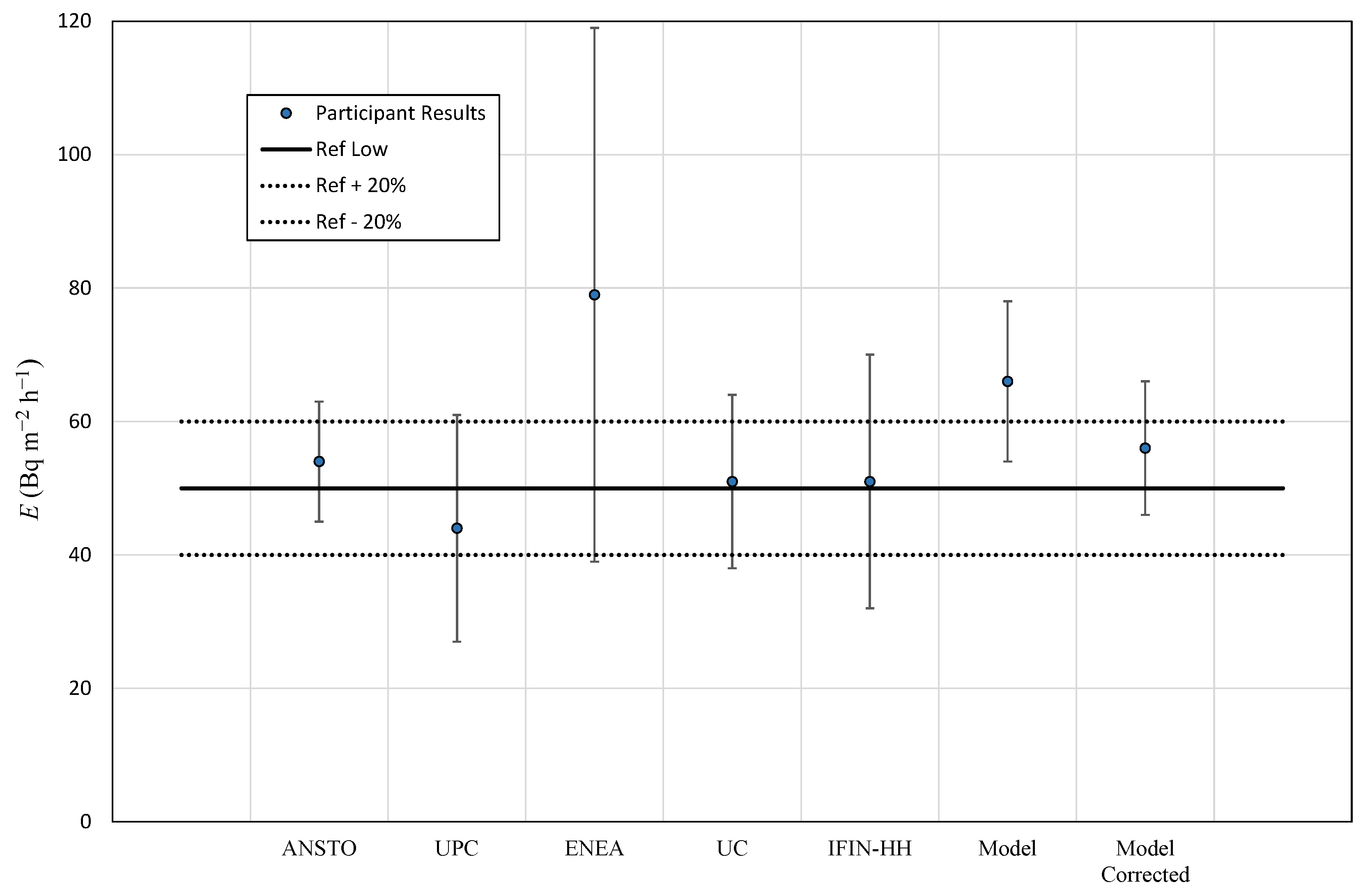2.2. Site Description
The intercomparison campaigns were performed in two different fields: a low and a high radium activity area. Sites were selected on the basin of their radium content in soil with the purpose of studying the response and behavior of the systems both in areas where low and high radon exhalation rates were expected. The procedure followed to place the devices in the soil surface was the same for both experiments. First, the grass layer was removed in an area of dimensions 2.80 m × 2.30 m to simplify the installation of the accumulation chambers in the ground. The relative position of every device was the same in both campaigns, as shown in
Figure 1. For each campaign, five soil samples were collected (at 4 corners and in the center of the area) in order to determine the average radium activity concentration (Bq/kg) of the field and the homogeneity. The samples were measured by the Laboratory of Environmental Radioactivity, University of Cantabria (LaRUC), accredited according to UNE-EN ISO/IEC 17025:2017 for activity concentration measurements of soil by gamma spectrometry using a high-purity germanium detector.
The site selected for the high radon flux campaign is within the land of a former uranium mine managed by the Spanish Uranium Company (ENUSA), located in Saelices el Chico (Salamanca, Spain) (latitude: 40.65, longitude: −6.63). The area chosen is called “Sageras”, and it is an undeveloped area near a pilot house built for radon remediation actions research [
21,
22]. The soil of the experimental area showed an average radium concentration of 814 ± 65 Bq/kg (k = 2).
Figure 2 shows an aerial view of the selected area and displaced monitors during the experiment.
The selected low radon flux area is a private house garden located in Esles de Cayón (Cantabria, Spain) (latitude: 43.28, longitude: –3.80), with an average radium concentration average of (29 ± 3) Bq/kg (k = 2). The low radon flux campaign was conducted between 13 and 28 October 2021.
Figure 3 shows an aerial view of this area and monitors during the experiment.
Additionally,
Figure 4 shows a boxplot of the monthly average of the radon flux predicted for these sites by the radon flux model presented in Karstens et al. 2015 using data for the period 2006–2010 based on soil moisture data from the Noah Land Surface Model in the Global Land Data Assimilation System (GLDAS Noah) [
7]. The average monthly values of this model output for October climatology was about 138 Bq m
−2 h
−1 and 66 Bq m
−2 h
−1 at the high and at the low radium content areas, respectively.
Karstens et al. 2015 successfully compared this model with another available radon flux model [
23], also based on radon transport equation in soil, and punctual radon flux measurements in Europe. The model, as declared by authors, calculates the radon source term proportionally to the
226Ra content of the soil. This is derived thanks to
238U values given in the Geochemical Atlas [
24] and the conversion factor from
238U concentration to
238U activity concentration [
25], i.e., 12.35 Bq kg
−1 per mg kg
−1 uranium. The radium concentration values extracted for the intercomparison areas were about 50 Bq/kg for the high radon flux area and of 35 Bq/kg for the low radon flux area.
For the high flux radon area, there is a great difference between the radium content in soil measured experimentally (814 Bq/kg) and the value used in the model (50 Bq/kg). Thus, considering the proportionality between the radium source term and the radon exhalation used into the model (138 ± 6 Bq m−2 h−1), the corrected radon flux from the model should be equal to 2247 ± 81 Bq m−2 h−1. Likewise, the radon flux proposed for the low radon flux area (66 ± 12 Bq m−2 h−1) has been corrected considering the radium content in soil measured experimentally (29 Bq/kg) in comparison with the value used by the model (35 Bq/kg). Therefore, the corrected radon flux value in this case is 56 ± 10 Bq m−2 h−1.
2.3. Radon Flux Calculation
The variation of the radon activity concentration
C with the time
t in the accumulation chamber can be modeled according to the differential equation [
26,
27]:
where
(Bq h−1): radon in soil production per unit of time;
V (m3): accumulation chamber volume;
(h−1): effective decay constant. Sum of the removal constants: , radon decay + backdiffusion + possible leaks of the system .
The solution of differential Equation (1) gives the radon concentration variation with time inside the chamber, which has an exponential behavior. Then, exhalation rate or radon flux
E can be obtained from the parameters given by exponential adjustment of Equation (1)’s solution:
where
Considering that the background radon concentration in the chamber
C0 is close to zero at the beginning of the accumulation process, the initial slope of the curve is independent of the backdiffusion [
28]. Assuming that initially, the loss of radon through leaks is negligible (
) and that
, the exponential term can be approximated by
according to Taylor series expansion. Therefore, the accumulation phase initially describes a linear growth of the radon concentration in the accumulation chamber described by:
where
h is the effective height, i.e., the ratio between
V, the effective accumulation chamber volume (volume of the system where the sampled air can circulate), and
S, the exhaling soil surface within the accumulation chamber.
The linear behavior given by Equation (3) depends on the value of the effective decay constant and the time considered.
Figure 5 shows the theoretical increase in the radon activity concentration in a given volume
V over 5 h, based on Equation (2) for several
values. It is observed that when there are no leakages,
, the behaviour of radon concentration is linear over the 5 h. However, for
, the trend of the radon concentration diverges from the linear behavior with time, in a way that, proportionally to the increase in
, the linear period of the curves decreases. To minimize the error made in assuming the linear behavior of radon concentration in a given volume, it is necessary to check when linearity is satisfied depending on the two mentioned parameters
and
.
This linear approach is useful to perform fast radon flux measurements needed to validate high temporal resolution models. As explained above, the linear behavior depends on the effective decay constant and the time considered . Thus, for a given system, to evaluate the maximum measurement period that satisfies the linear behavior, the following should be considered: the of the system and the time frequency response of the radon monitor used, to ensure enough data to reduce the measurement uncertainty, not forgetting that could be variable over the measurement period due to environmental effects.
The radon exhalation value used for the theoretical approach in
Figure 5 is the same for all the curves; the only difference between them is the effective decay constant. Considering different time periods, radon flux can be calculated from the curves using Equation (3). Then, the error due to the linear approximation can be obtained as the difference between the radon flux calculated assuming linearity and the real value. Maximum linearity time
t can be estimated as a factor of λ for a fixed level of maximum deviation; 10% and 20% are considered here (see
Figure 6). Given that, a relationship
is obtained with
= 0.287 for 10% and
= 0.625 for 20% maximum deviation. A similar theoretical study was completed [
18,
19] considering two points for the linear fit, but in this approach, pairs of values every 10 min from
Figure 5 were used.
To check the applicability of the linear approach in the intercomparison campaigns, a static accumulation experiment is conducted at the beginning of the measurement to determine the effective decay constant λ of each system from the exponential adjustment of Equation (2). Considering the experimental uncertainties of radon measurements, we established an acceptable deviation of 20% to theoretically calculate the maximum linearity time.
From the data of the static accumulation measurement, radon flux is obtained both by using Equation (2) and also by the linear fit to Equation (3) using several time intervals for the first 5 h; then, these values are compared. Afterwards, taking into account the theoretical approach shown in
Figure 6 and the type of device and its characteristics (integration time, radon monitor response, etc.), it is decided how much time should be considered for the linear fit in the next accumulation periods.
The static measurement experiment (24 h duration) intends to serve as reference to determine the leakage from the exponential adjustment, but before, it has to be considered that immediately after the installation of the chamber into the soil, some time should be allowed for the exhalation conditions to reach equilibrium. After the static measurement, the dynamic measurement commences; a flowchart explaining the measurement procedure followed for the campaigns is presented in
Figure 7.
